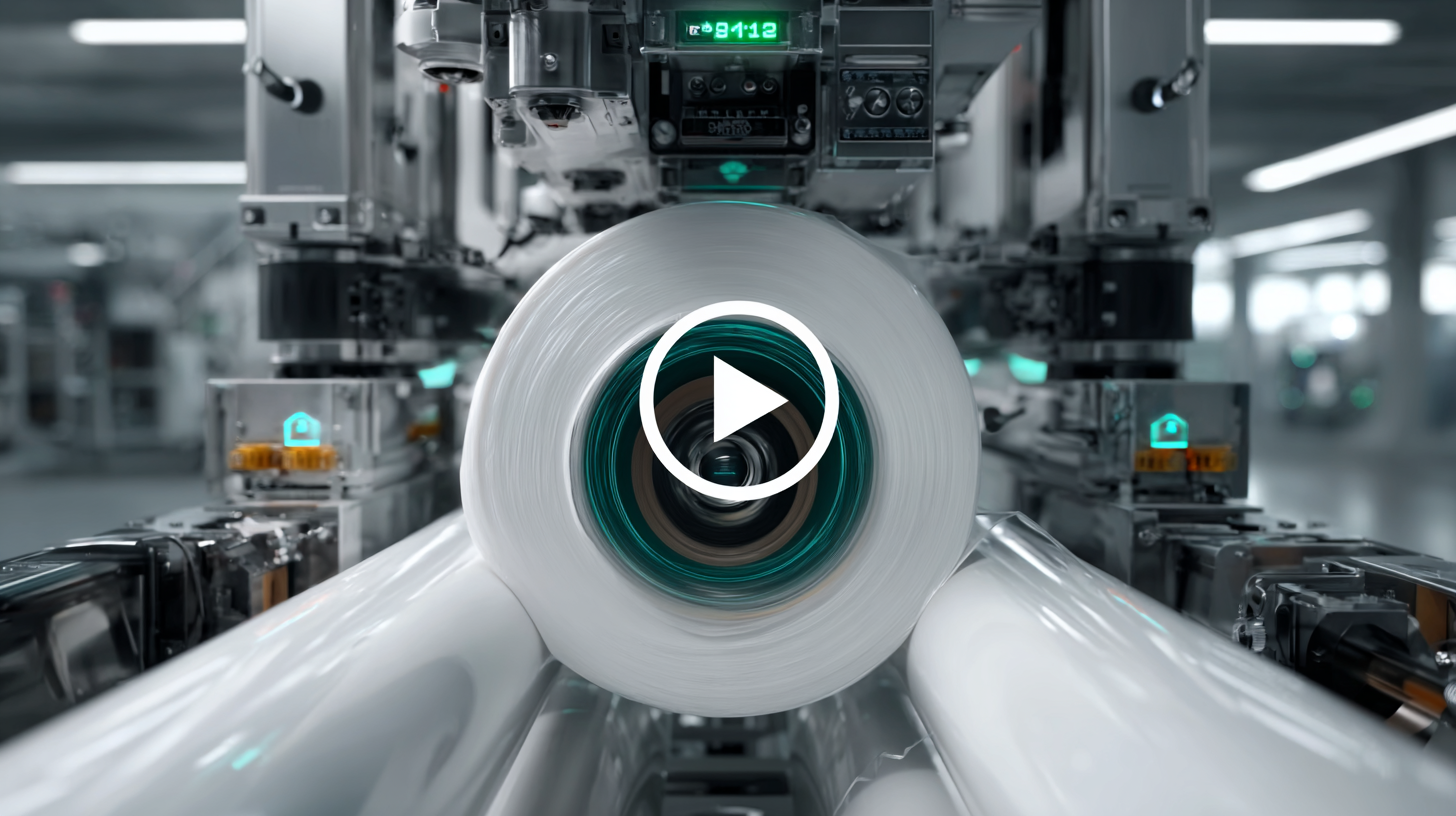
Navigating the Future of Packaging with Best OPP Film in 2025 Tech Trends and Essential Checklist
As we look towards 2025, the packaging industry is on the brink of transformative changes driven by technological advancements and sustainability demands. According to a recent report by Smithers Pira, the global flexible packaging market is projected to reach $300 billion by 2024, showcasing a strong growth trajectory that emphasizes the importance of innovative materials.

Among these, OPP Film (Oriented Polypropylene Film) has emerged as a key player due to its versatility and eco-friendliness, making it ideal for various applications from food packaging to consumer goods. As companies strive to enhance their packaging solutions, understanding the tech trends and employing an essential checklist for OPP Film adoption is crucial for staying competitive in this rapidly evolving landscape.
This blog will explore the future of packaging, highlighting the significant role of OPP Film and key strategies for businesses to navigate these changes effectively.
Understanding OPP Film: Key Features and Advantages for Packaging in 2025
 Oriented polypropylene (OPP) film is set to revolutionize the packaging industry in 2025, thanks to its remarkable features and benefits that cater to modern requirements. One of the key advantages of OPP film is its excellent clarity, which enhances product visibility on shelves, making it a popular choice among retailers. Additionally, OPP films are lightweight yet strong, providing efficient protection for a variety of products without adding unnecessary bulk to the packaging.
Oriented polypropylene (OPP) film is set to revolutionize the packaging industry in 2025, thanks to its remarkable features and benefits that cater to modern requirements. One of the key advantages of OPP film is its excellent clarity, which enhances product visibility on shelves, making it a popular choice among retailers. Additionally, OPP films are lightweight yet strong, providing efficient protection for a variety of products without adding unnecessary bulk to the packaging.
When considering OPP film for packaging, it's essential to keep a few tips in mind. First, prioritize the specific needs of your product—OPP films come in various thicknesses and finishes, allowing for customization based on the nature of the item being packaged. Second, ensure that you collaborate with suppliers who can provide high-quality OPP films, as the integrity of the packaging directly affects the overall perception of your brand.
Another critical feature of OPP film is its resistance to moisture and chemicals, making it ideal for food and non-food applications alike. For businesses aiming to adopt more sustainable practices, exploring options for recyclable OPP films can further enhance your packaging strategy. Embracing these trends in OPP film technology will not only improve your packaging solutions but also align your brand with the eco-conscious ethos of 2025.
Emerging Tech Trends in Packaging: Innovations Reshaping the Industry
The packaging industry is experiencing a revolutionary shift driven by technological innovations. In 2025, the focus will be on integrating sustainable materials with advanced manufacturing processes. One prominent trend is the increased use of biodegradable and compostable films, which are designed to minimize environmental impact while maintaining the integrity of the products within. Brands are gradually recognizing the importance of eco-friendly packaging solutions, prompting a rise in investments in research and development for new materials, such as plant-based bioplastics.

Additionally, smart packaging technology is gaining traction, enabling brands to engage consumers in new ways. Features such as QR codes and NFC tags are being incorporated into packaging design, allowing for real-time tracking of product freshness as well as interactive customer experiences. This blending of digital and physical realms not only enhances consumer engagement but also optimizes supply chain efficiency. As we head further into 2025, it's clear that the convergence of these innovations will reshape the packaging landscape, pushing businesses to adapt and evolve alongside emerging tech trends.
Essential Factors to Consider When Choosing the Best OPP Film
When selecting the best OPP (Oriented Polypropylene) film for packaging in 2025, several essential factors come into play. First, clarity and transparency are vital attributes of OPP films, as they enhance the visual appeal of products while providing excellent barrier properties. Brands aiming to present their products attractively should prioritize films that maintain high clarity and brightness, as this can significantly influence consumer purchasing decisions.
Another critical consideration is the film's compatibility with various printing techniques. In an era where branding is crucial, the ability to print high-quality designs directly onto the packaging can elevate a product's market presence. Moreover, it’s important to assess the film's heat-sealing capabilities, as efficient sealing can lead to better product protection and reduced waste. Choosing a film that offers flexibility in sealing temperatures will enhance operational efficiency during packaging processes.
Lastly, sustainability is becoming increasingly important in the packaging industry. Selecting OPP films that are recyclable or made from recycled materials can align with consumer demand for eco-friendly products. Brands that adopt sustainable practices not only foster loyalty among environmentally conscious consumers but also contribute to a healthier planet, making sustainability a hallmark consideration when choosing the best OPP film for the future.
Sustainable Packaging Solutions: Balancing Performance and Environmental Impact
In navigating the future of packaging, the emphasis on sustainable solutions becomes paramount. Recent advancements demonstrate a significant shift towards materials like starch-based biopolymers, which align with eco-friendly practices in food packaging. These renewable resources are not only effective but help to reduce the environmental footprint associated with conventional packaging methods.
When considering sustainable packaging, it’s essential to evaluate key performance metrics that inform the environmental impact throughout the packaging lifecycle. Implementing a circular supply chain model is crucial for achieving these goals, facilitating reuse and recycling of materials, thus minimizing waste. As industries adopt this model, they can better balance cost-effectiveness with ecological responsibility.
**Tips**:
1. Explore materials with a lower environmental impact, such as starch or recycled content films, which can enhance sustainability without sacrificing performance.
2. Utilize life cycle assessments to compare different packaging solutions, focusing on their environmental impact, from production to disposal.
3. Stay informed about emerging trends in sustainable packaging to continually adapt and improve your packaging strategies.
Navigating the Future of Packaging with Best OPP Film in 2025 Tech Trends and Essential Checklist - Sustainable Packaging Solutions: Balancing Performance and Environmental Impact
| Packaging Type | Material | Sustainability Score | Performance Rating | Cost Efficiency | Market Trend |
|---|---|---|---|---|---|
| Flexible OPP Film | BOPP | 8.5 | 9.0 | Affordable | Increasing Use |
| Biodegradable Film | PLA | 9.5 | 8.0 | Moderate | Rapid Growth |
| Recycled Content Film | rPET | 8.2 | 9.5 | Cost-Effective | Stable Demand |
| Compostable Film | PVOH | 9.0 | 7.5 | Higher Cost | Emerging Interest |
| Smart Packaging | OPP with Sensors | 7.0 | 9.8 | Premium | Growing Trend |
A Comprehensive Checklist for Implementing OPP Film in Your Packaging Strategy
As businesses look to streamline their packaging processes, incorporating OPP (Oriented Polypropylene) film into their strategy has become an essential consideration. OPP film offers superior barrier properties, making it an ideal choice for protecting products while enhancing shelf life. To effectively implement OPP film in your packaging strategy, start with a thorough assessment of your current packaging needs and product specifications. Identify the types of products you require packaging for and determine the necessary qualities, such as moisture resistance and clarity.
Next, ensure you have a clear understanding of the manufacturing capabilities related to OPP film. Consult with suppliers about their product ranges, thickness options, and any customization that may be beneficial for your brand. Additionally, consider conducting pilot tests to evaluate how the film performs with your specific products. This step is crucial for recognizing any potential challenges before full-scale implementation. Finally, integrate sustainability into your packaging strategy by exploring recyclable and biodegradable OPP film alternatives, ensuring that your approach is not only efficient but also environmentally responsible.
Future of Packaging Trends in 2025: OPP Film Adoption
This chart illustrates the importance levels of various trends influencing the adoption of OPP film in packaging strategy by 2025. Key areas include sustainability, cost efficiency, product protection, shelf appeal, and consumer demand, showcasing their significance for the future of packaging.
